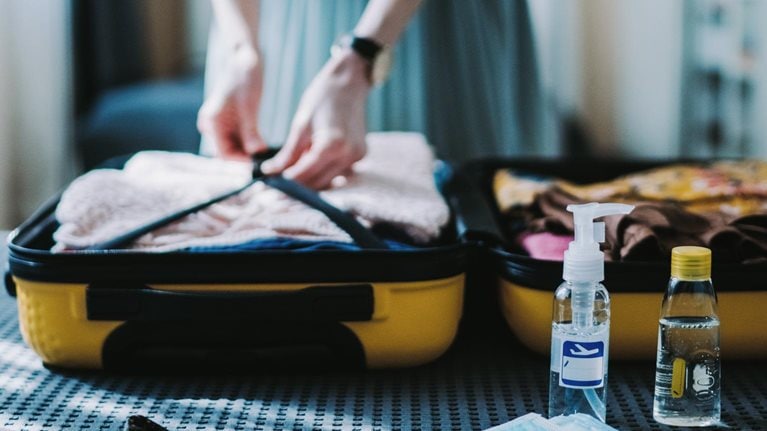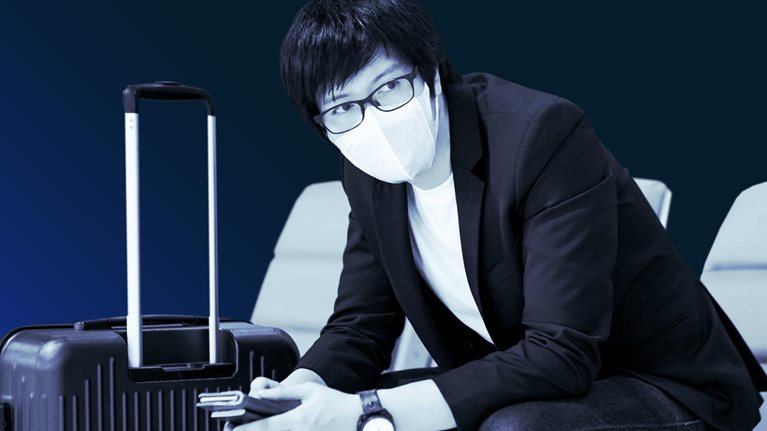It seems that, finally, the light at the end of the pandemic tunnel is in sight—at least in some parts of the world. In 2020, total global business travel expenses contracted by 52 percent, while managed corporate-travel spending in the United States plummeted 71 percent, or $94 billion. Last year, when we reported on the impact of COVID-19 on corporate travel, we projected that the road to recovery would be a long and uneven one.
Much has changed since then, thanks largely to progress on the vaccination front. Even though there’s much debate surrounding the timing of herd immunity in the United States, it’s indisputable that vaccination rates are on the rise across the country. At the time of writing, more than 40 percent of the US population has been fully vaccinated, with more than 50 percent having received at least one dose. Companies are starting to bring employees back to offices. Corporate executives are planning in-person meetings and gatherings with customers and colleagues.
In light of new developments, to what extent will videoconferencing replace business trips? How should corporations prepare for the next phase of business travel? While our insights from last year still hold, we’ve sharpened our understanding of how business leaders could be thinking about the postpandemic role of corporate travel. In this article, we identify four categories of business travelers—the “never left,” the “never returning,” the “fear of missing out” (FOMO), and the “wait and see” segments—and provide recommendations for how key players in the corporate-travel ecosystem can make effective plans in this context.
What’s changed: Increased vaccination is expanding flexible work arrangements
The most significant change shaping our thinking about the return of corporate travel is the rising vaccination rates in the United States and Europe. We project that the United States and the United Kingdom will slowly transition toward normalcy in mid-2021, with the rest of the European Union following shortly after (Exhibit 1).

Notwithstanding the risks presented by new virus strains and limited visibility into the duration of vaccine immunity, rising vaccination rates are ameliorating some of the travel anxiety. Many organizations are now proactively figuring out the future of work—which includes the role of business travel.
For many companies, COVID-19 has proven that more workplace flexibility is possible. Around 70 percent of executives said their companies will employ more temporary workers than before the pandemic, and 72 percent of executives report that their companies have started to adopt permanent remote-working arrangements for a subset of their employees. Nearly 40 percent of the workforce in the United States has the potential to work from anywhere. These signals and others suggest that many organizations are reevaluating working and organizational arrangements, including when, why, and how their employees should hit the road.
There’s no consensus, however, among business leaders about what to do with this newfound flexibility, and many organizations have not yet clearly communicated a vision for postpandemic work: around 30 percent of executives in a recent survey say they have not heard about specific plans for corporate travel after the pandemic, while another 28 percent described their companies’ plans as vague.
Four key segments in the return of corporate travel
Breaking down corporate trips into different segments can help travel planners and suppliers plan for the return of corporate travel. We’ve identified four different business-travel profiles, each sitting at a different point on the travel-resilience spectrum. Three indicators were used to define each archetype and determine its position on the spectrum: sector, travel purpose, and whether the trip was domestic or international. For travel purpose, if in-person interactions remain critical for a company, then the more resilient such business trips are. Some assumptions were made on how likely it was that some forms of corporate travel would recover rather than be substituted by videoconference technology.
The profile mix varies from company to company, and it’s possible for all four to coexist within the same organization, although some might feature more prominently in some companies and less in others.
- The “never left” segment. On one end of the spectrum, employees for whom travel is deemed essential for conducting business resumed their trips as soon as lockdowns eased. This category accounted for around 15 percent of all corporate travel expenses in 2019 and includes managers in manufacturing companies with a wide distribution of factories and plants and field-operation workers. Those who were reluctant to fly opted for rail and private cars instead.
- The “never returning” segment. On the other end, business travelers that contributed to one-fifth of business travel spending in 2019 present an enticing opportunity for corporations to permanently slash their corporate-travel budgets. Digital adopters who are able to maintain high levels of effectiveness while working remotely may never return to corporate travel. Furthermore, advances made in digital technologies that enhance oversight of outposts have paved the way for corporate travel to be further reduced. For instance, many chain restaurants found ways to minimize corporate travel by replacing in-person visits with virtual alternatives, as well as establishing more local oversight systems. They are likely to want to keep these significant cost savings; although a certain number of business trips will continue after the pandemic even in this segment, they will do so at much lower levels than before.
- The “fear of missing out” (FOMO) segment. The bulk of business travel (60 percent of business-travel expenditure in 2019)—which will likely drive the rebound of corporate travel—will be fueled by the FOMO segment: those traveling to cultivate important client relationships. Small and medium-size enterprises (SMEs) will likely increase corporate travel at much faster rates, as they are not subject to the heightened approval process that large enterprises have to follow. SMEs are likely to trigger a domino effect where one company’s resumption of business trips will catalyze its rivals’ return to work-related travel. Faced with intense competition, different players in the company (leadership, management, staff) coalesce to reinstate corporate travel at scale to seize a first-mover advantage over rival businesses. An April Global Business Travel Association (GBTA) member survey reported that more than 50 percent of respondents are developing or plan to develop a timeline for resuming travel, updated travel policies, or new safety resources and information for travelers.
- The “wait and see” segment. This segment consists of workers in relatively noncompetitive industries and roles; it contributed 5 percent of total business-travel spending in 2019. These corporate travelers tend to come from the public sector, professional associations, and nonprofits. During the pandemic, many professional associations were able to hold virtual events to replace in-person conferences and will likely be more cautious in their return to travel.
Taken together, the trajectories of the four travel categories confirm our earlier projection of an uneven recovery for corporate travel. Overall, we can expect a 20 percent reduction in corporate travel spending by 2023.
In addition, it’s worth noting that even within these segments, business-travel recovery will vary depending on the purpose and distance of the business trips (Exhibit 2). For instance, even for firms in the “never left” segment, overseas travel to attend international conferences has not returned because of government-imposed restrictions due to public-health concerns. Furthermore, given the uneven rollout of COVID-19 vaccines internationally, the return of international travel may be further suspended in regions with limited or delayed access to vaccines due to sustained public-health restrictions and/or disease outbreaks. On the flip side, “never returning” business travelers may still make exceptions for key events that are held regionally.

In the United States, a comparison of a multinational conglomerate’s internal and external travel spend and that of a private health insurer provides an example of how the recovery trajectory may differ from business to business (Exhibit 3). Internal travel encompasses trips taken for intracompany purposes, where employees participate in activities such as training, team building, or inspection of field operations. External travel, on the other hand, refers to trips employees take for engagements outside the company, including in-person meetings with clients and suppliers, trade conferences, and customer sales calls.

The multinational conglomerate we examined, a manufacturer of building products, had a total travel spend in 2019 of around $80 million. As a customer-driven business, the company spends the majority of its travel expenses on external travel. Much of this falls into the FOMO segment, which is already recovering at a faster pace this year relative to internal travel even though the overall travel expenditure remains depressed. The bulk of its internal travel was for the purposes of internal collaboration in 2019, a third of which is expected to be permanently eliminated, while the rest should gradually return over the rest of this year and 2022.
On the other hand, travel recovery has unfolded rather differently for the health insurer. In 2019, it spent a larger portion of its travel budget on internal conventions, sales-leader celebrations, and cross-state executive meetings and collaborations. Most of these trips were part of the client-facing “never left” segment, which has returned to regular travel more quickly than other segments have. As the company tentatively restarted its business trips, this “never left” cohort was the priority. While overall travel spend is expected to be only 10 percent of 2019 levels, 80 percent of it would go to internal travel. External travel for the most part will remain suspended in 2021, given the restrictions on visiting customers that are based mainly in hospitals and healthcare facilities. By 2023, the company is planning to fully recover its internal travel spend, although it is still debating whether it is necessary to visit suppliers in person.

Watch
A McKinsey Live event on 'Returning to corporate travel: How do we get it right?'
Approaching the future of corporate travel: Four steps
Charting a safe and effective road map for future corporate travel requires all players to collaborate. Key players in the ecosystem—suppliers (including airlines, hotels, car-rental and rideshare companies), corporate-travel planners, travel intermediaries such as online travel agencies (OTAs), global-distribution-system (GDS) providers, and travelers themselves—need to master four critical skills: leveraging real-time data, planning with agility, aiming for comfort and safety, and communicating with clarity.
Leverage real-time data
Planning for the future can feel like flying through a fog of uncertainty, which makes it even more important for players to leverage real-time data to inform their decision making. Organizations could invest in data capabilities to identify and monitor the first signs of an acceleration in business travel.
OTAs and GDS providers may be worth exploring as new data sources. Travel intermediaries such as these are uniquely situated to provide aggregate data for each industry. For instance, they can inform a corporate-travel planner how many seats are being booked by the rest of the company’s sector, signaling whether the company is ahead of or behind the curve. Many corporate-travel planners are also concerned about the fluctuations in the cost and availability of tickets, given the volatility of flight schedules during this time. Intermediaries can provide data that suggest which flights are more likely to stay on an airline’s schedule, helping clients build more agility into their decision making. Intermediaries may be able to create a new revenue stream from these data.
Would you like to learn more about our Travel, Logistics & Infrastructure Practice?
Real-time data also help suppliers of corporate travel, such as air carriers and hotels, become more agile. As corporate travel returns, these suppliers will need to deploy the right resources in real time to match demand, which may shift abruptly. For example, one airline made a costly mistake by being unprepared for the sudden spike in demand for leisure flights over the recent Easter holiday. As recovery will likely be uneven, airlines will have to figure out how to have aircraft, pilots, and crew on standby so they can increase capacity quickly whenever there’s a need. Organizations can meet regularly to discuss data-driven insights and align on next steps.
Embed agility into planning
It pays to have a detailed plan and strategy for different recovery scenarios in place. When demand picks up, many firms may find that they don’t have the time to pause and think through their strategies.
When it comes to organizing business trips for employees, corporate-travel planners will need to take into account four considerations:
- First, the factors that affect whether corporate travel should increase: for example, local and regional infection levels, customer demand, and competitive actions.
- Second, the relevant data sources used to evaluate these factors: these could include public-health indicators, customer surveys, data from travel partners on industry trends and competitor behavior, and real-time pricing from GDSs consistent with typical corporate agreements, even as airline-fare classes go through realignments.
- Third, company policies on business travel: What distance-based policies should staff adhere to? Should they use rental cars, rideshares, taxis, or flights? When should they wear masks or engage in group gatherings? How (and should) companies distinguish between what activities vaccinated and unvaccinated employees can participate in?
- Fourth, information needed by travelers: this includes websites, travel help desks, and messaging.
A US health-products wholesaler and manufacturer provides an example of how these considerations work together. Currently, the company’s factories are open, while corporate offices remain closed and corporate travel is at a standstill. The company recently decided to stage-gate the resumption of corporate travel, starting with executives. Critical sales meetings and conferences will be in the next wave of business trips, followed by general sales and internal corporate activities, and finally, internal training and events. The level of corporate travel varies by state, based on local infection and vaccination rates. The company also set up tracking codes in its customer-relationship-management system to monitor when sales are won or lost due to competitive travel, which involved working with its corporate travel agent to get data on corporate-travel bookings.
The company instituted different policies for each level, including when masks must be worn, the permitted group size for indoor gatherings, and what lodging choices should be made (for example, home shares are avoided for safety and sanitation reasons). The company is developing internal brochures and a communications plan to keep its employees informed.
Personalize experiences based on safety and comfort
Safety and comfort are crucial elements in the travel experience, and they can sometimes pull in opposite directions. More can be done to bridge this gap. Both employers and travel companies could find ways to give passengers peace of mind and improve comfort and convenience. The guiding principle here is giving the traveler greater control over decisions that affect their sense of comfort and security.
For instance, airlines can personalize flight experiences by improving the functionality of their mobile apps to allow passengers to preorder their meals and snacks or make special requests. Hotels may let guests decide on the frequency and timing of housekeeping. They might consider offering initiatives that improve guests’ physical and mental well-being, for example, by offering virtual trainers to guide meditation or fitness practices. Suppliers could also consider offering radically transparent flexibility policies and allow customers a greater range of options with different associated fees for cancellations and changes.
Communicate with clarity
Even the most seasoned travelers have to accept that traveling has changed. Masks have become ubiquitous, and border restrictions, boarding procedures, and hygiene requirements seem to be ever changing. It’s critical that organizations communicate clearly what their corporate-travel policies are at any given moment in time, for every stage of the journey—from pre- to post-trip.
It helps for organizations to be extra proactive in communicating any type of change, whether regarding company-wide strategic policies or more granular details such as the company’s preferred rideshare or car-rental options for corporate travel. When changes in operations are made, companies can take special care to ensure the availability of amenities. Leadership can play a prominent role in modeling how to travel in this new reality by clearly reiterating company policies. Information websites, travel help desks, and easily digestible infographics could all be used to get the message across. Keep channels of communication open and allow employees to give feedback and raise concerns as and when they arise.
Employees, too, will go through an adjustment period as they resume their business trips. Leadership can communicate that it’s OK for them to take it slowly and that they should raise concerns if they ever feel unsafe.
Some corporate travelers will find they have to adapt quickly to the many changes in business travel, while others will have the luxury of easing themselves in over a longer period. Unpredictability will continue to be a fact of life, but one thing is certain: if everyone plays their part well (and smartly, by leveraging the technologies and processes at our disposal), the resumption of corporate travel is possible.


